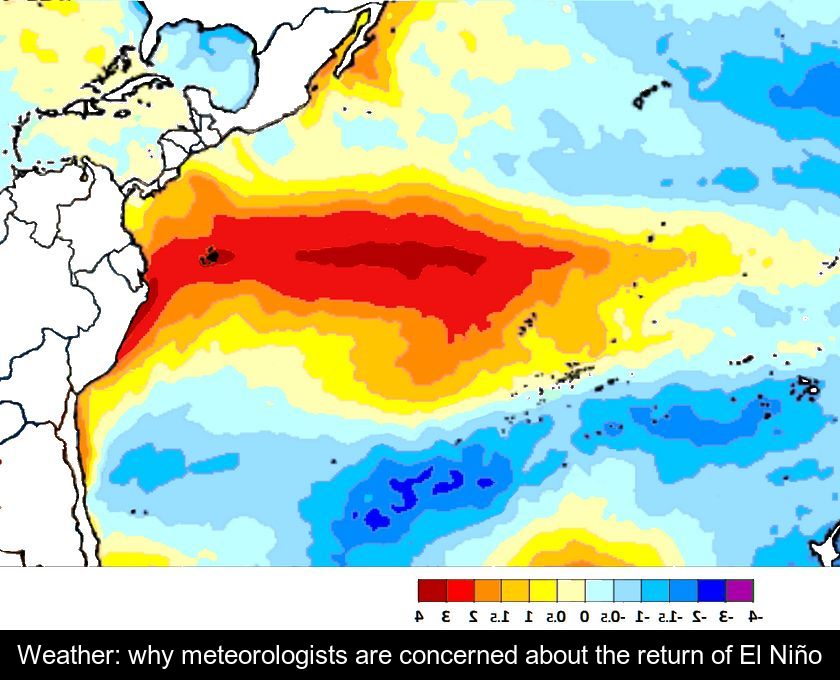Weather: Why Meteorologists Are Concerned About The Return Of El Niño
After three years of absence, El Niño could return with more strength in 2023. This phenomenon having a 'hot impact' on the global climate, its return worries scientists and forecasters who anticipate new heat records on the planet.
A feared weather anomaly
El Niño literally means 'the current of the Child Jesus' because this warm current that passes off the coast of Peru and Ecuador usually appears around Christmas... But it is also sometimes called the enfant terrible of the climate!
By extension, this term refers to a meteorological anomaly characterized by an abnormal rise in ocean temperature in the central and eastern part of the South Pacific.
When this climatic phenomenon occurs, the atmosphere warms locally and globally, with varying consequences in different parts of the world.
Did you know?
El Niño and its cold little sister La Niña were identified in 1924 by the British Gilbert Walker. Between them, these currents constitute the most energetic climate phenomenon on the planet known as the Southern oscillation, Southern Oscillation or ENSO.
A return at the worst possible time
After three years of lulls due to La Niña, the return of El Niño this year comes at the worst possible time.
Indeed, scientists fear that this meteorological anomaly will be combined with a sudden slowdown of the Gulf Stream, which is usually one of the main drivers of climate regulation.
Even though record warmth was recorded in 2022, which was the 5th warmest year on record, we have so far benefited from the cooling effect of La Niña, an oceanic phenomenon that limits temperature increases.
Conversely, El Niño warms the waters of the Pacific and can disrupt weather over much of the globe. This phenomenon has already been responsible for the absolute temperature record recorded in 2016 (+ 1.2°C compared to the pre-industrial era).
This time, its impact on temperatures could be intensified by global warming and cause unprecedented heat waves.
Record temperatures are expected
In concrete terms, the return of the El Niño phenomenon could result in the highest temperatures recorded on Earth since the pre-industrial era!
Forecasters at the Met Office, the British national weather service responsible for annual and decadal forecasts for the World Meteorological Organization, or WMO, anticipate that the average global temperature for 2023 'should be between 1.08°C and 1.32°C above the average observed over the past century.'
These ominous predictions have a good chance of being accurate, as this study is rated with 66% certainty. If confirmed, climate disasters could follow, including unprecedented heat waves.
Various consequences on the planet
Even though the El Niño phenomenon has a warm impact on the climate, its consequences are not the same in different parts of the world. It can cause flooding in some countries and drought in others...
This climatic anomaly does not only make the mercury rise. Pacific Rim countries like Indonesia and Australia will be directly affected by warming waters, with warmer and drier weather, increasing the risk of drought and forest fires.
It is also causing a lack of water in the Amazon rainforest, the Australian rainforest and parts of the African forests. In the United States, its impact varies by region: the climate becomes wetter in the Southwest, warmer in the Northwest, and drier throughout the East.
In Europe, the impact of the Southern Oscillation or ENSO is not well known. Some studies have hypothesized that this phenomenon leads to drier and colder weather in northern Europe and wetter weather in southern Europe. But, to date, the effect of El Niño in this area has not been proven as it has been in other regions of the world.
A boost to global warming
With the return of this phenomenon, scientists especially fear that global warming will cross a new threshold at + 1.5°C.
According to the most pessimistic forecasts, this symbolic bar could be crossed in 2024 under the warming effect of El Niño, with dramatic consequences on biodiversity but also on human health and agriculture.
In the event of a strong El Niño, coral reefs in the eastern Pacific can bleach and rice harvests can be cut in half in some regions such as India and Indonesia.
According to forecasters, the return of this oceanic phenomenon is increasingly confirmed for late spring or early summer 2023. Nevertheless, the precise date when its effects will be felt and the magnitude of this phenomenon remain difficult to determine at this time. The intensity of this weather anomaly is indeed related to the strength of the westerly gales, which is impossible to predict at this time.











